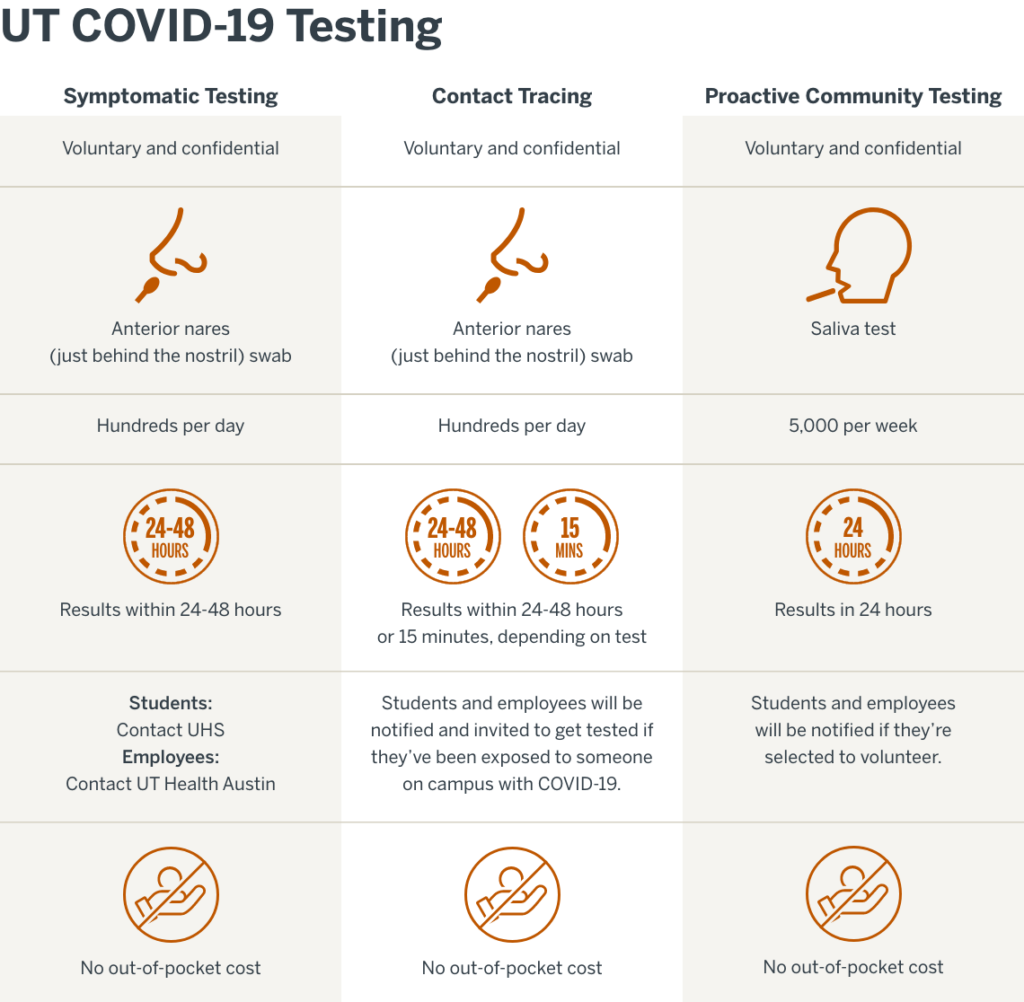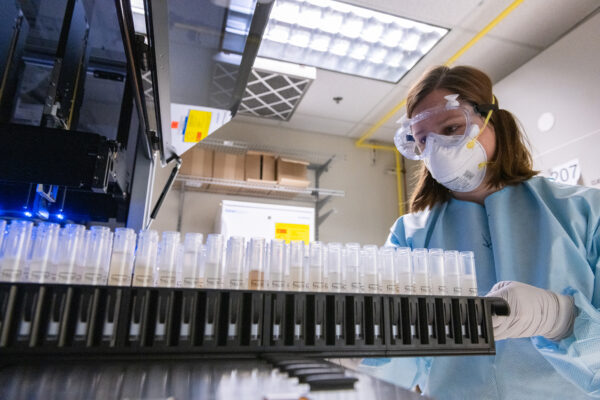-
Students with COVID-19 symptoms can get a test at no out-of-pocket cost and receive their results in 24 to 48 hours.
-
The university will be able to strategically test 5,000 students and faculty and staff members weekly who don’t have symptoms to identify any hot spots on campus.
-
When someone tests positive, teams will conduct contact tracing and additional testing to minimize the spread of the virus.
When the novel coronavirus began spreading across the United States this spring, The University of Texas at Austin quickly purchased three state-of-the-art robots and assembled additional equipment capable of processing hundreds of COVID-19 test samples every day.
The machines, which sort saliva samples and search for the virus’s genetic material, are just one part of a wide-reaching, in-house infrastructure the university has built to ensure its on-campus community remains safe amid the pandemic.
The multimillion-dollar effort ensures that UT will be able to test hundreds of symptomatic students and faculty and staff members every day, as well as an additional 5,000 each week who do not have symptoms — something known as proactive community testing — at no cost to them.
“It’s not a trivial thing to set up testing like this in a research operation,” says Andreas Matouschek, a professor in the College of Natural Sciences and the director of the Center for Biomedical Research Support. Today, if you tried to buy much of this equipment, it is backordered for months, and prices have escalated. “The university started to prepare for the time students would come back to campus right after going online in the spring,” he said.
In-house facilities are important so the university can continue to test even if a surge in demand overwhelms private labs, causing delays and backlogs.
“Having internal labs shields us from some of the fluctuations the community may experience with testing availability,” says Dr. Terrance Hines, executive director and chief medical officer of University Health Services. “It also allows us to have a much faster turnaround time on results and benefits the community by freeing up commercial lab capacity for city use.”
The university will conduct three types of COVID-19 assessments this fall: symptomatic testing, testing conducted as a part of contact tracing, and proactive community testing.

Symptomatic Testing
Students who have COVID-19 symptoms can visit University Health Services in the Student Services Building to receive tests at no out-of-pocket expense. (In cases where insurance does not cover the cost of a test or a student is not insured, the university will cover the costs.) Medical staff will administer a painless swab in the front part of the nose and are able to process hundreds of tests a day in a lab on-site. The results are expected to take only 24 to 48 hours to receive. Faculty and staff can receive the same tests, covered by their insurance, through UT Health Austin.
Contact Tracing
If individuals should test positive for the virus, they can agree to contact tracing, which UT Health Austin chief clinical officer, Dr. Amy Young, says will be conducted by a team of trained staff members who locate and inform anyone the person came into contact with. The university will test these individuals — also at no cost to them — to quickly identify anyone who is infected and minimize the spread of the virus.
UT will use some of its rapid tests, which produce results in only 15 minutes, so individuals who have a negative result do not have to quarantine unnecessarily. If they test positive, contact tracers can immediately begin the work of identifying others who may have been exposed to the virus.
Proactive Community Testing
UT will be able to test up to 5,000 students and faculty and staff members who don’t have symptoms each week. University epidemiologists and data scientists will strategically identify where the virus is most likely to show up on campus, then they will ask for testing volunteers.
Proactive community testing helps UT scientists make inferences and projections about the on-campus infection rate. If there are any changes in that rate among asymptomatic volunteers — rising, falling or holding steady — the university can identify any COVID-19 clusters early and make important campus decisions.
Anybody on campus may be asked to volunteer, including research scientists, faculty members, students, health care workers, and information technology support employees and others working on campus. The goal is not to test the entire student or staff population but to identify potential hot spots. The university will also use these tests to expand contact tracing efforts when necessary by testing entire offices or the wing of a dorm — all things that would be nearly impossible without in-house labs and resources.
Proactive community assessments will use saliva test kits. Volunteers will receive an email with a time window and location for testing. The samples will be processed at a specialized lab at the Neural and Molecular Science Building called the High Throughput Testing Core (HTTC) lab, also known as “the Core.” This is where the three liquid-handling robots will ferry the thousands of tests through machines to detect for the virus’s genetic material.
The testing operation is a collaboration among several UT units, including the Office of the Vice President for Research, the College of Natural Sciences, the Department of Diagnostic Medicine at Dell Medical School, and University Health Services.
“They really stepped up and performed in a spectacular way,” Matouschek says of the team effort.
The university does have contracts with outside labs, including Clinical Pathology Laboratories, if it needs additional testing resources. All students living in campus residence halls will also be tested within the first two weeks of moving in.
Testing is just one piece of the university’s effort to ensure a safe return for students this fall. Other measures include mandatory mask policies, social distancing and reduced density classrooms. More than 75% of the seats in class will be online, and only 5% will be fully in person. The remaining 20% will be offered through hybrid courses that mix online and in-person elements.




